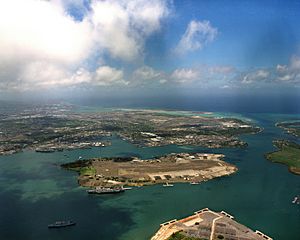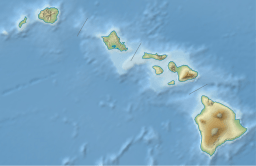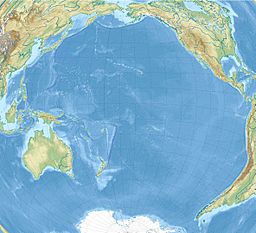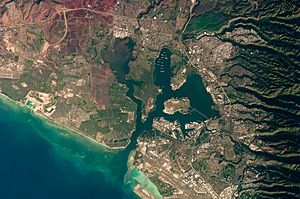Pearl Harbor facts for kids
Quick facts for kids Pearl Harbor |
|
|---|---|
| Coordinates | 21°22′04″N 157°58′38″W / 21.3679°N 157.9771°W |

Pearl Harbor is a famous lagoon harbor located on the island of Oahu, Hawaii. It is west of the city of Honolulu. This harbor was often visited by the United States Navy fleet. The U.S. gained control of it from the Hawaiian Kingdom after signing the Reciprocity Treaty of 1875. Today, a large part of the harbor and the land around it is a major United States Navy base. It is also the main office for the United States Pacific Fleet.
The U.S. government first got the right to use this harbor and set up a repair and coaling station for ships in 1887. A surprise attack on Pearl Harbor by the Imperial Japanese Navy happened on December 7, 1941. This attack led the United States to declare war on Empire of Japan. It marked the United States' entry into World War II.
Contents
History of Pearl Harbor
Pearl Harbor was once a wide, shallow bay. The Hawaiians called it Wai Momi, which means “Waters of Pearl.” They also called it Puʻuloa, meaning “long hill.” In Hawaiian legends, Puʻuloa was believed to be the home of the shark goddess, Kaʻahupahau, and her brother, Kahiʻuka.
According to old stories, a powerful chief named Keaunui made a channel for boats near the Puʻuloa saltworks. This made the area, known as "Pearl River," open for ships. Even though the bay likely had an opening already, Keaunui is often given credit for making it wider and deeper.
How the U.S. Became Interested
In the early 1800s, large ships could not use Pearl Harbor because its entrance was too shallow. The United States became more interested in the Hawaiian Islands because of its whaling, shipping, and trading in the Pacific Ocean. By 1820, an American agent was sent to Honolulu to manage U.S. business. American missionaries also came to Hawaii and became important in Hawaiian politics.
Many American warships visited Honolulu in the 1820s and 1830s. Their commanders often carried letters from the U.S. government. These letters gave advice on how Hawaii should manage its government and its relationships with other countries. In 1841, a Honolulu newspaper called Polynesian suggested that the U.S. should build a naval base in Hawaii. This base would protect American citizens involved in the whaling business.
After the American Civil War, trade with Hawaii grew. The U.S. also bought Alaska and saw the Pacific states become more important. In 1865, the North Pacific Squadron was created to cover the western coast and Hawaii. A ship called Lackawanna was sent to Hawaii in 1866. It surveyed the Northwestern Hawaiian Islands and helped the United States claim Midway Island.
By 1868, 42 American flags were seen on ships in Honolulu, compared to only six from other countries. This busy activity led to at least one U.S. warship being permanently stationed in Hawaiian waters. Congress also approved money in 1869 to make the harbor at Midway Island deeper.
After 1868, U.S. naval officers played a big role in Hawaii's affairs. They helped settle business disagreements and negotiate trade deals. They also helped keep law and order. Members of the Hawaiian royal family and government officials often traveled on U.S. warships.
When King Lunalilo died in 1873, talks were happening to give the U.S. special rights to Pearl Harbor. This would allow sugar from Hawaii to be sent to the U.S. without taxes. During the time of King Kalākaua, the United States was given the special right to use Pearl Harbor. They could set up a place to refuel and repair ships there.
The United States and the Hawaiian Kingdom signed the Reciprocity Treaty of 1875. This treaty was confirmed in 1887. On January 20, 1887, the United States Senate gave the Navy the special right to have a coaling and repair station at Pearl Harbor. The U.S. officially took control on November 9 of that year. The Spanish–American War in 1898 and the U.S. desire to have a strong presence in the Pacific helped make this decision.
After the Hawaiian Kingdom was overthrown, the United States Navy built a base on the island in 1899. On December 7, 1941, the base was attacked by airplanes and small submarines from the Imperial Japanese Navy. This attack caused the United States to enter World War II.
One reason for the surprise attack was that different parts of the U.S. military and government did not share information well. There was no good plan for defending Hawaii from an air attack. American commanders did not fully understand how powerful air forces could be. If the U.S. Pacific Fleet had known about the warnings, its ships might have been at sea on December 7. If they had been sunk in deep water, it would have been impossible to rescue them.
After the attack, two American military leaders, Lt. Gen. Walter Short and Adm. Husband Kimmel, were lowered in rank. They are now trying to get their full ranks back.
After World War II
Pearl Harbor stayed a main base for the U.S. Pacific Fleet after World War II. It shared this role with Naval Base San Diego. In 2010, the Navy and the Air Force combined their two nearby bases. Pearl Harbor joined with Hickam Air Force Base to create Joint Base Pearl Harbor–Hickam.
On February 18, 2016, a helicopter carrying tourists crashed into Pearl Harbor. Four people were hurt, and one person went missing.
Japanese Prime Minister Shinzo Abe announced on December 5, 2016, that he would visit Pearl Harbor with U.S. President Barack Obama. This trip marked 75 years since the attack. It was the first official visit by a sitting Japanese leader.
Environmental Concerns
On October 14, 1992, the U.S. Environmental Protection Agency added the Pearl Harbor Naval Complex to its superfund list. This list includes places with serious pollution that need to be cleaned up.
See also
 In Spanish: Pearl Harbor para niños
In Spanish: Pearl Harbor para niños





